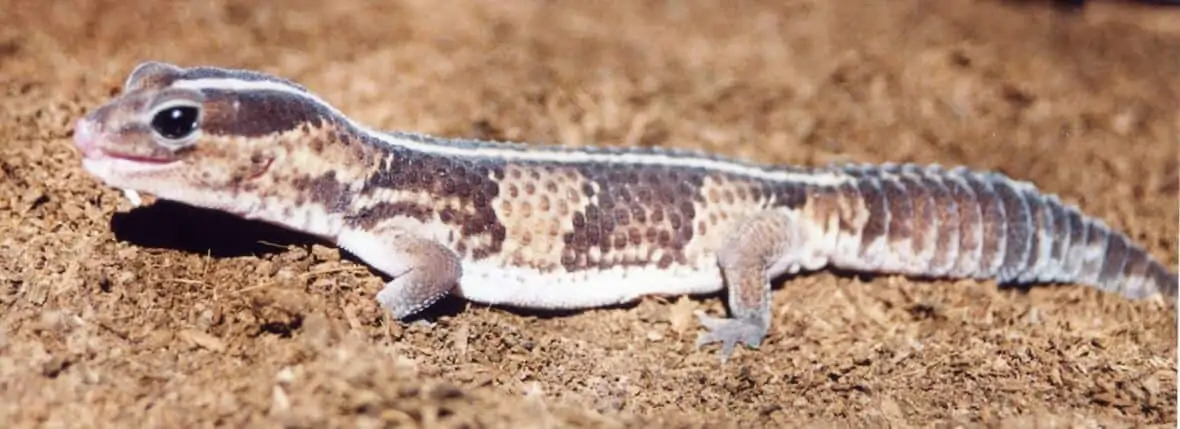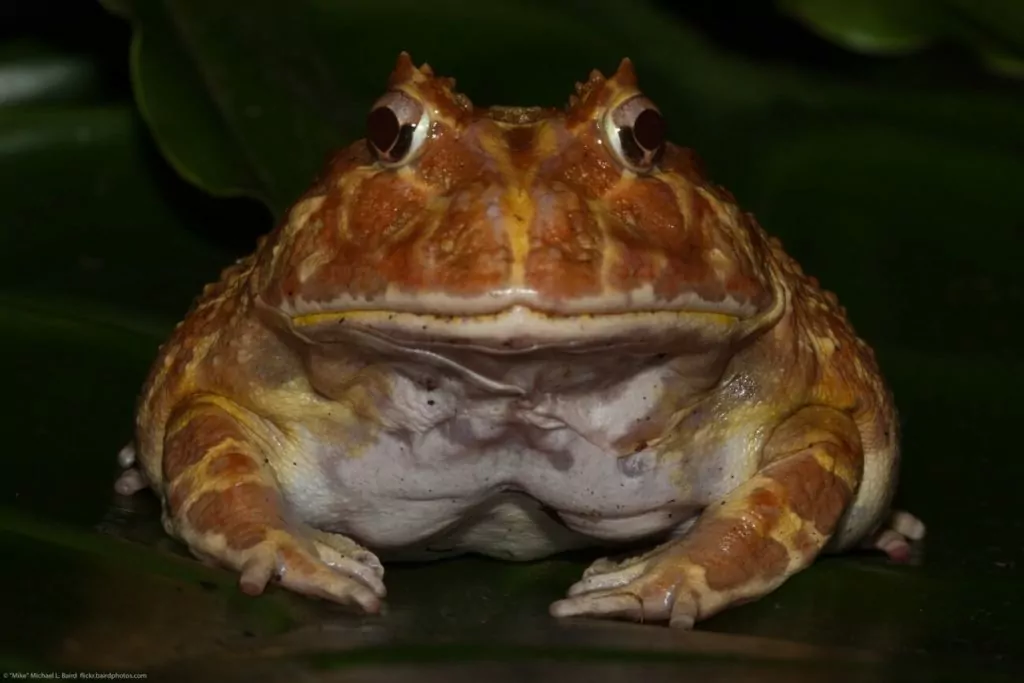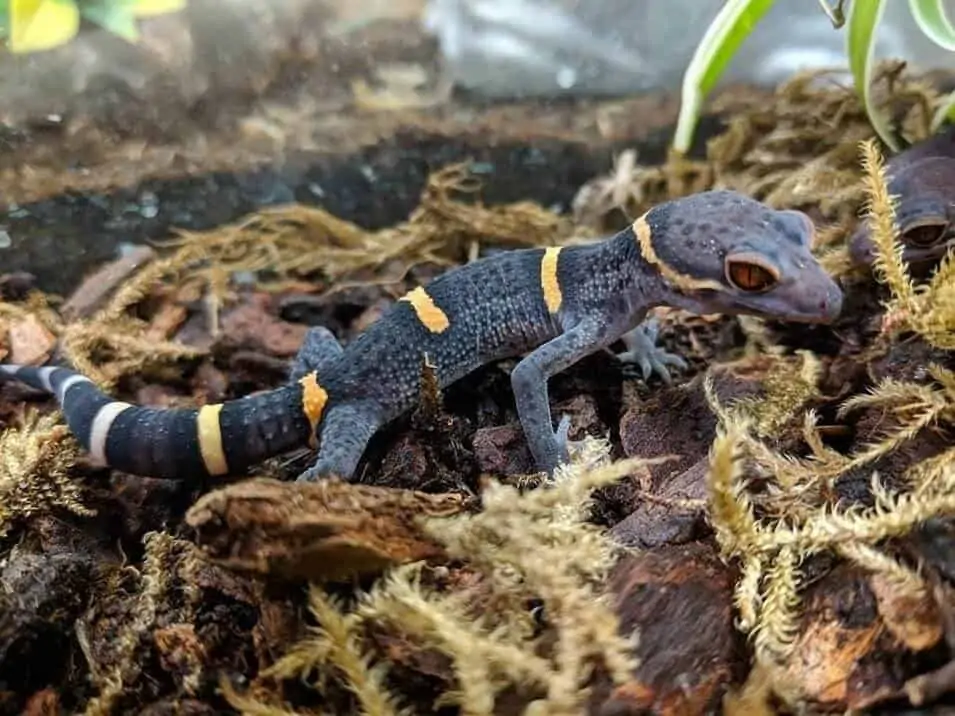The African fat-tailed gecko is a reptile we recommend all the time. They’re peaceful, easy to care for, and look great!
We’ve been a fan of these lizards for years and have enjoyed seeing this species grow in popularity. It seems like every reptile-lover we know has one.
This guide will go over all aspects of African fat-tailed gecko care to make you ready whenever you decide to get one for yourself.
Enjoy!
Table of Contents
Species Summary
The African fat-tailed gecko (Hemitheconyx caudicinctus) is a lesser-known species with a lot to offer reptile enthusiasts.
While they may not be as popular as other gecko species, these good pet lizards are extensively bred in captivity. As a result, they’re readily available and affordably priced.
These geckos are native to arid environments throughout West Africa. Many reside along river edges or savannah lands stretching from Cameroon to Senegal.
Despite those extreme natural environments, African fat-tailed geckos do quite well in captivity. They’re docile by nature and generally undemanding when it comes to the quality of their habitat.
As long as the basics are provided, these reptiles can happily live in the same enclosure for decades!
African Fat-Tailed Gecko Lifespan
The average African fat-tailed gecko lifespan is 10 to 25 years. They’re capable of living quite a long time, but their ultimate life expectancy is dependent on the quality of care you provide.
There is some degree of chance to it, but good husbandry can do a lot to help these geckos live long lives. When you don’t provide them with their essential needs, your gecko may only make it to the lower end of that lifespan range.
Appearance & Colors
While they do look similar to other gecko species from Africa, the African fat-tailed gecko has some distinct characteristics that make it unique.
And the most obvious is its tail!
These geckos develop large rounded tails that are often compared to caterpillars. They are bulbous in the middle and taper off to a dull point. The tail is used to store fat for energy. However, they can easily lose it during fights with other reptiles.
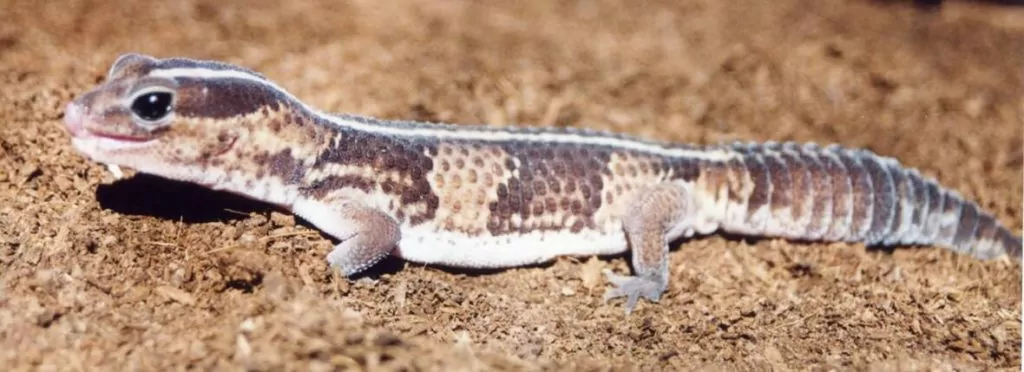
The good news is that the tail can grow back. Redeveloped tails are usually a bit rounder than the original. It may also take on a completely different color than the reptile’s first tail.
The African fat-tailed geckos has small, but strong, legs. They’re also sporting tiny agile fingers that help them climb and burrow. Interestingly enough, the feet are not sticky like most geckos.
The head of the African fat-tailed gecko has a couple of distinct features, too. First, they have functioning eyelids! They help to shield the eyes from flying dust. Second, these geckos have vertical pupils that are similar to what you would see on a snake.
As for color, there are several morphs in the trade. The most common morph features thick bands of brown and tan. The bands run vertically along the entire body, providing some nice camouflage.
Expert Tip: A thin white line is pretty common, too. It can run along the back of the gecko to create a nice accent.
More exotic color morphs are available from some breeders. You might see geckos with shades of bright red and orange. Others are white and patternless! These color morphs are rarer and generally come with a higher price tag.
Average Size
African fat-tailed geckos are relatively small. Most will be around seven to nine inches in length.
Expert Tip: Males often reach the upper end of that size range. Females stick closer to seven inches.
African Fat-Tailed Gecko Care
African fat-tailed gecko care really isn’t too difficult once you know what these lizards need. Considered an excellent species for beginners, these reptiles are quick to adapt to live in captivity.
That said, you still need to be vigilant about providing these reptiles with the right environment, diet, and lifestyle! They come from extreme environments that you have to replicate.
Here are some care tips to help you make that happen.
Enclosure Size
You’ll be happy to know that a large enclosure is not necessary. They can do very well in terrariums that are as small as 10 gallons in size.
Aim for an enclosure that measures at least 20 inches long, 10 inches wide, and 12 inches tall.
A tank of that size is more than enough for a single gecko. It can even hold a small group of three!
Expert Tip: We do recommend going bigger if possible since a larger tank will increase their quality of life. A 20-gallon terrarium that measures 30 inches long, 12 inches wide, and 12 inches can provide more space for your geckos to live comfortably.
Choose a glass-walled terrarium with sliding doors and vents. The glass will help to keep humidity levels stable while the vents can provide ventilation whenever it’s needed.
Recommended Habitat Setup
The goal when setting up an African fat-tailed gecko’s habitat is to replicate the conditions that they would experience in the wild.
The first thing to focus on is providing the right substrate. These geckos require materials that can absorb moisture.
Porous materials like coconut fiber, shredded newspaper, orchid bark, and cypress mulch work well. You can also create a mixture of coconut bedding and sandy soil. Pure sand shouldn’t be used by itself as it can cause digestive problems when eaten.
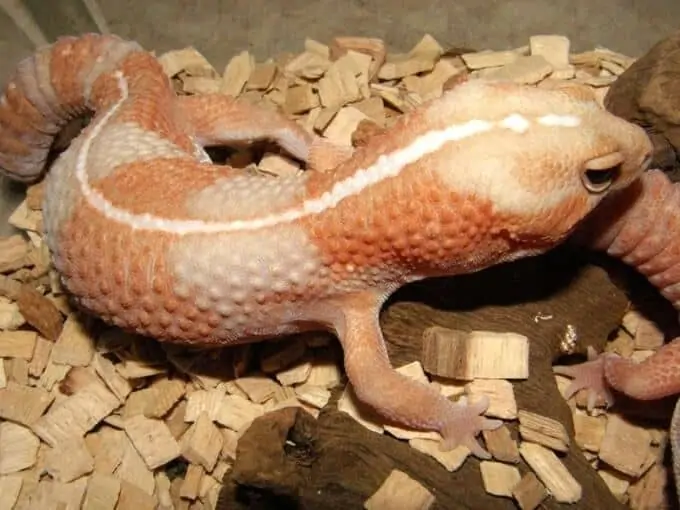
On top of the substrate, you can add some real or fake plants. Real plants can be advantageous because of their ability to increase humidity levels, but fake plants will do if you don’t want to worry about maintenance.
To spice up the environment, add some fake rock decor. You can also add some wood and create shelter.
Hide boxes are essential for the geckos. Whether you use prebuilt boxes or make one from natural materials, the box should be large enough for all of your geckos to fit in.
Add some moss to the inside of the box. The shelter is going to be a high-humidity place that geckos can go to get comfortable. They often use it during times of shedding, so extra humidity is a nice touch.
Place at least two boxes into the habitat. They should be placed on opposite ends of the enclosure.
Temperature & Lighting
One of the easiest parts of African fat-tailed gecko care is the lighting requirements. That’s because these reptiles are completely nocturnal!
This means you really don’t have to use any lighting at all. Ambient lighting will do just fine.
That said, you do need to keep temperatures stable.
Some reptile enthusiasts will use light to warm the habitat up. But, you can use under-tank heating mats to achieve the same effect.
It’s important to create a temperature gradient. African fat-tailed geckos are cold-blooded creatures that will self-regulate their body temperature by moving to different parts of the enclosure.
One end of the tank should have temperatures between 90 and 95 degrees Fahrenheit. You can use a light to give the reptiles a place to truly bask. But the gecko will only use it on rare occasions.
The opposite side of the enclosure should be significantly cooler. Temperatures in the upper 70s or low 80s are best.
Humidity
High humidity levels are a must for these lizards! This is an area where you need to be accurate and consistent.
Expert Tip: Use a reliable hygrometer to check the levels daily and make adjustments as needed.
To keep the reptiles healthy, humidity levels in the tank need to be at least 40 percent (50 percent or above is ideal though). On the upper end of the spectrum, the geckos can tolerate levels as high as 70 percent!
To increase humidity levels, mist the enclosure. That moisture-absorbing substrate from earlier comes in handy here! When you mist the enclosure the substrate will prevent it from absorbing too fast.
If you need to lower humidity levels, just open up the air vents to increase air circulation throughout the environment.
Water
African fat-tailed geckos will need a source of water to drink from. This means you’ll need to provide a small water dish that the lizard can get its head into comfortably.
Keep the dish filled with fresh filtered water. The cleanliness of the water will have a big impact on their overall health and lifespan.
These geckos might soak in the dish from time to time, which makes the water quite dirty. If this happens, clean up the dish and replenish their water supply.
Food & Diet
A proper African fat-tailed gecko’s diet should include nothing but high-protein insects! These reptiles are insectivores, so they will not accept leafy greens or vegetables.
Here are some of the best options:
- Crickets
- Waxworms
- Mealworms
- Caterpillars
- Silkworms
- Canned snails
Before providing the insects make sure that they’re gut-loaded for good measure. An easy way to do this is by simply dusting them with calcium powder and vitamin supplements every other feeding.
Some geckos will also eat small pinky mice, but a treat like that should be reserved for special occasions.
Expert Tip: Don’t feed the geckos anything that’s bigger than the space between their eyes. Provide daily meals for juveniles. Adults can eat three to four times a week.
Potential Health Issues
African fat-tailed geckos can suffer from all of the same potential health issues as other reptiles in captivity. This includes respiratory infections, mouth rot, and even bacterial infections.
In most cases, those diseases are a sign that conditions aren’t quite right in the enclosure. For example, improper humidity levels are usually the culprit for mouth rot and respiratory infections. Addressing the issue should prevent future problems from occurring.
Another common health problem with African fat-tailed geckos is a disease called Cryptosporidiosis. Caused by a parasite that lives in soil and water, the disease can wreak havoc on a gecko’s body.
It will usually make the usually fat tail look very thin as well. The gecko may also experience runny stool.
Fortunately, the parasite that causes this disease is easy to avoid. You just have to keep the enclosure clean! Spot clean messes every day and perform a deep clean at least once a month.
When you do that deep clean, remove everything from the habitat. Then, use a reptile-approved sanitizing product. This will get rid of any bacteria and prevent parasites from taking over the habitat!
Behavior & Temperament
As nocturnal animals, you’re not going to see a lot of activity during the day. At night, the reptiles may spend some time relaxing in their hide or basking on the warm side of the terrarium.
When you feed them in the evening, you might see some interesting predatory behaviors. When eating live insects, they might raise their tails up and start waving them in an attempt to distract the insects before striking!
African fat-tailed geckos do just fine in solitary enclosures. While you can keep them in groups, you must be careful about how you house them.
You should never keep two males together. Males are notoriously territorial and will fight until they lose their tails. Before the aggression begins, you might hear some squeaks or clicking sounds. This is a form of communication that the geckos often use before they start getting physical.
Aggressive behaviors won’t be a problem if you don’t house two males together. You can also keep one male and multiple females. Another obvious option is to only keep females. They aren’t as defensive or territorial.
Handling Advice
One of the best parts of owning an African fat-tailed gecko is handling them! These reptiles don’t have a problem being handled once they’re comfortable with their new environment.
Give them some time to adjust before you attempt to handle them. Building trust and allowing them to get comfortable will make the entire process easier.
The species is known for being very docile and responsive to owners. They rarely scratch or bite and will not jerk around in your hands. Many will walk right into your hands when you present them on the floor of their habitat.
As long as you’re gentle and pay attention to the signs these lizards give you, you shouldn’t have any problems with handling.
Expert Tip: As always, make sure you wash your hands after handling to avoid any bacterial transmissions!
Conclusion
As you can see, African fat-tailed gecko care is a piece of cake. As long as you’re mindful of the conditions these lizards require you shouldn’t run into any issues.
This is why we find ourselves recommending these reptiles to beginners so often. They are very low-maintenance and easy to form a bond with!
If you have any other questions about this species feel free to send them over. We do our best to include as much useful advice as possible (plus helpful facts), but it’s impossible to cover everything!

